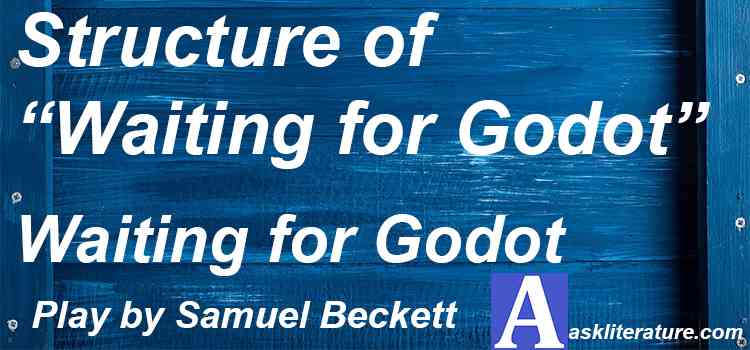“Waiting for Godot” does not follow the congenital play structure. It has no action which is soul of a tragedy (drama), therefore, it is entirely different from other plays.. Samuel Becket has proved Aristotle wrong in many ways. He has proved that the concept viz. “there can be a tragedy without character but not without action” has become old now. He has written a play without “a proper beginning, middle and end”. Still his play is successful. Many critics have remained failed to answer the reason behind the success of this novel. The play has nothing in it yet it glues the audience to the chairs. It has gained much success; even it has been translated and perfumed many countries. Its freshness can be felt even today. Samuel Becket has violated the traditional rules of playwriting yet this play is successful and given him fame. The play has no story, no plot, no characterization even then it is successful. Traditional writers were used to write plays with good plots, strong characterization and good actions but “Waiting for Godot” lacks all these necessary ingredients. It does not fulfill even a single requirement of traditional dramatists. Samuel Becket experimented with theater and he became famous. Thus, in order to judge “Waiting for Godot”, we have to consider view of critics and the interest of audience. It cannot be adjudged on the basis of comparison technique; it is entirely a new concept, therefore, it cannot be compared to any traditional play.
There is no exposition, development, reversal and denouncement in the play. Its structure is based on repetition; both acts have similarity in many ways. Not only dialogues are repeated but actions are also repeated; both acts end without any development. There are some similarities in both the acts. For instance, in both the acts, Estragon feels problem with his feet and boots; he is beaten by strangers in both acts; comic conversation involving carrots, radishes and turnips is available in both the acts; Vladimir has problem with his urination in both the acts; they decide to commit suicide in both acts; three characters come and go in act-I; similarly these three characters visit in act-ii of the play; their visit has been repeated; both acts end with let’s go but none of them moves from his place. Thus, there is repetition everywhere in the play, however, this repetition sometimes becomes ironical, which does not let the audience leave their chairs. Undoubtedly, the play has repetition but this repetition has its unique importance. It is interesting and compels the audience to watch the whole play. Moreover, there is a little difference in every repetition; sometimes there is different in intensity of dialogue delivery; somewhere there is difference in the actions; somewhere in words. Thus, these little changes always drift the emotions of audience.
There are very less characters in the play but Samuel Bucket has created contrasting characters. Every character is different to each other. Estragon and Vladimir although are dependent on each other yet they are entirely different; there is difference in their thinking; one likes telling funny stories other find them bore; one shows his sympathies with Lucky, others has fellow feeling for him. Similarly, Pozzo is entirely dependent on Lucky but his is totally different from him; there social status is different; their philosophy is different; their behavior is different. Hence, it is also an importance feature of the play “Waiting for Godot” that it has contrasting characters.
Vivian Mercier’s views are considerable. He has briefly defined the structure of this play in following words:-
“a theatrical impossibility—a play in which nothing happens, that yet keeps audiences glued to their seats. What’s more, since the second act is a subtly different reprise of the first, he has written a play in which nothing happens twice.”
Similarly, there are some other views of critics regarding structure of this play. One critic says: this play is “undramatic but highly theatrical”. He has also suggested it “not as undramatic but as a parody of the drama”.
The characters, themes, setting, dialogue, etc. reflect and emphasize the circular structure in “Waiting for Godot”, due to which we notice no development in the plot. Hence, the play ends as it has begun. The play repeats same themes as are available in other plays of Samuel Becket i.e. Boredom and sufferings of human beings.
There are short dialogues in the play. Except speeches, every dialogue is short. Audience finds no ambiguity in understanding the motif behind dialogues. Furthermore, every dialogue of the play is symmetric; it is symmetric structure due to which the time of the play has been filled. Fast questioning and fast answering; sometimes there is a silence between the dialogues but it is not frequent. It is only there, where it is required.
Dialogues of the play have a symmetrical structure; Act-I and act-ii are symmetrical. Similarly, there is verbal symmetry. While talking about symmetries a critic writes: “symmytry to suggest a static design”, whereas another critic suggests: the play has “asymmetric structure” but none of them has said that the play follows the rule of tragedy as defined by Aristotle in his book “Poetics”.
Upshot of the above discussion is that like theme of the play, its structure is also based on “nothingness”. Characterization is very less; nothing happens twice; there is no change in acts; motif of the characters does not change; they do not move from one play to another; there is no reversal of fortune. The play violates every single rule of a perfect tragedy. Astonishing feature of this play is that it has gained fame despite the fact that it has nothing in it. Thus, with respect to structure, it is a new concept. Samuel Becket does not belong to any school. It is his experiment on theater and astonishingly he become successful in it. His experiment has given him eminence in the world of theater. Thus, structure of “Waiting for Godot” is entirely unique.
